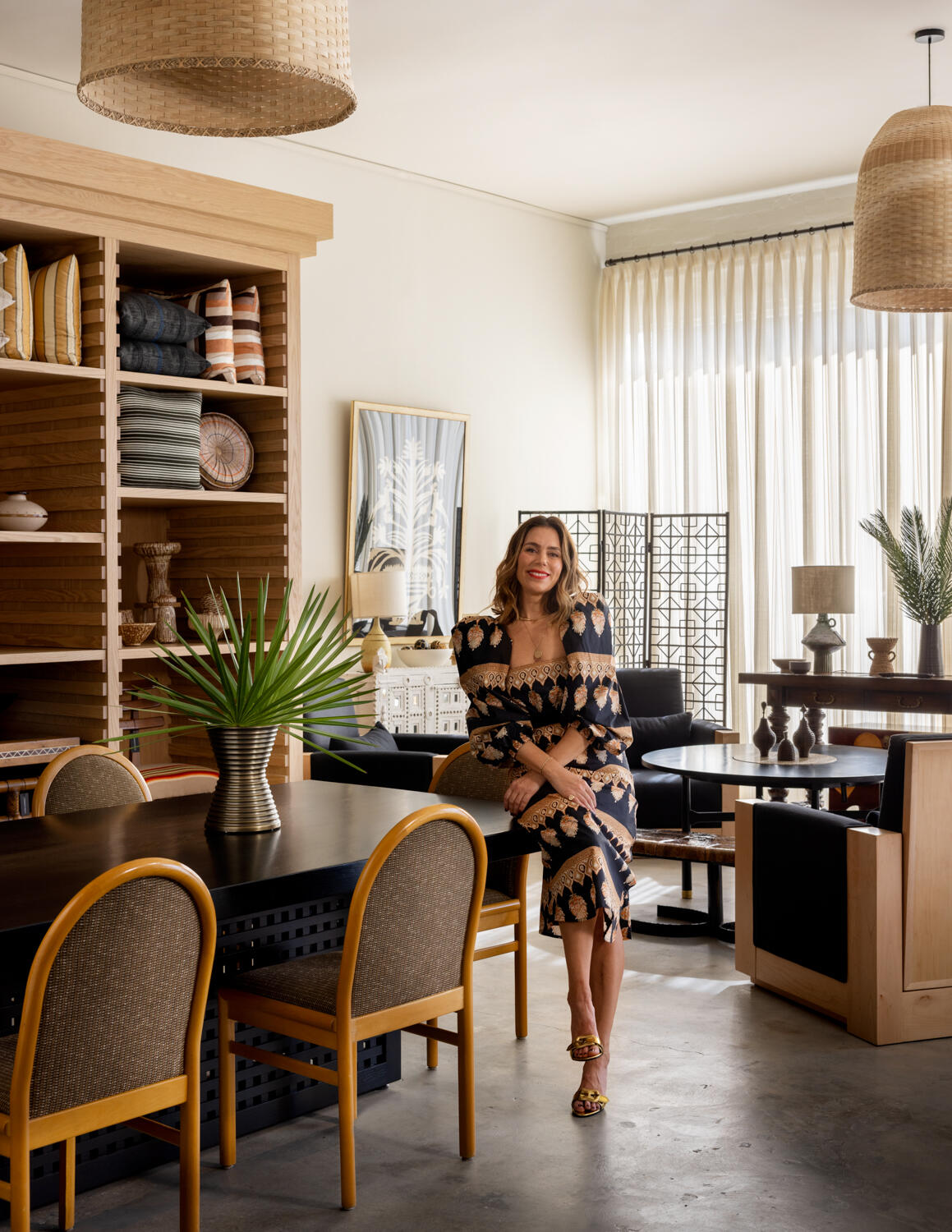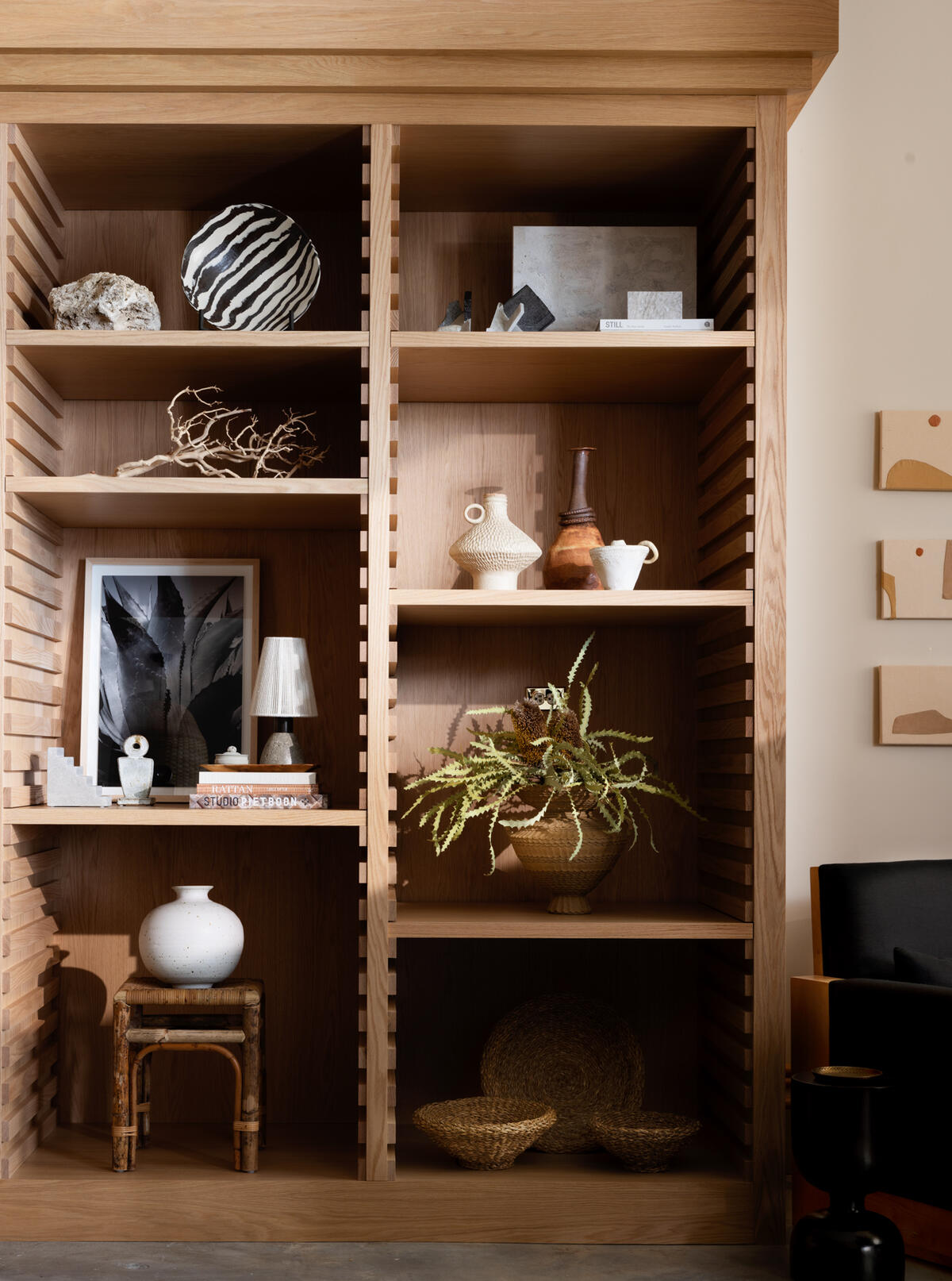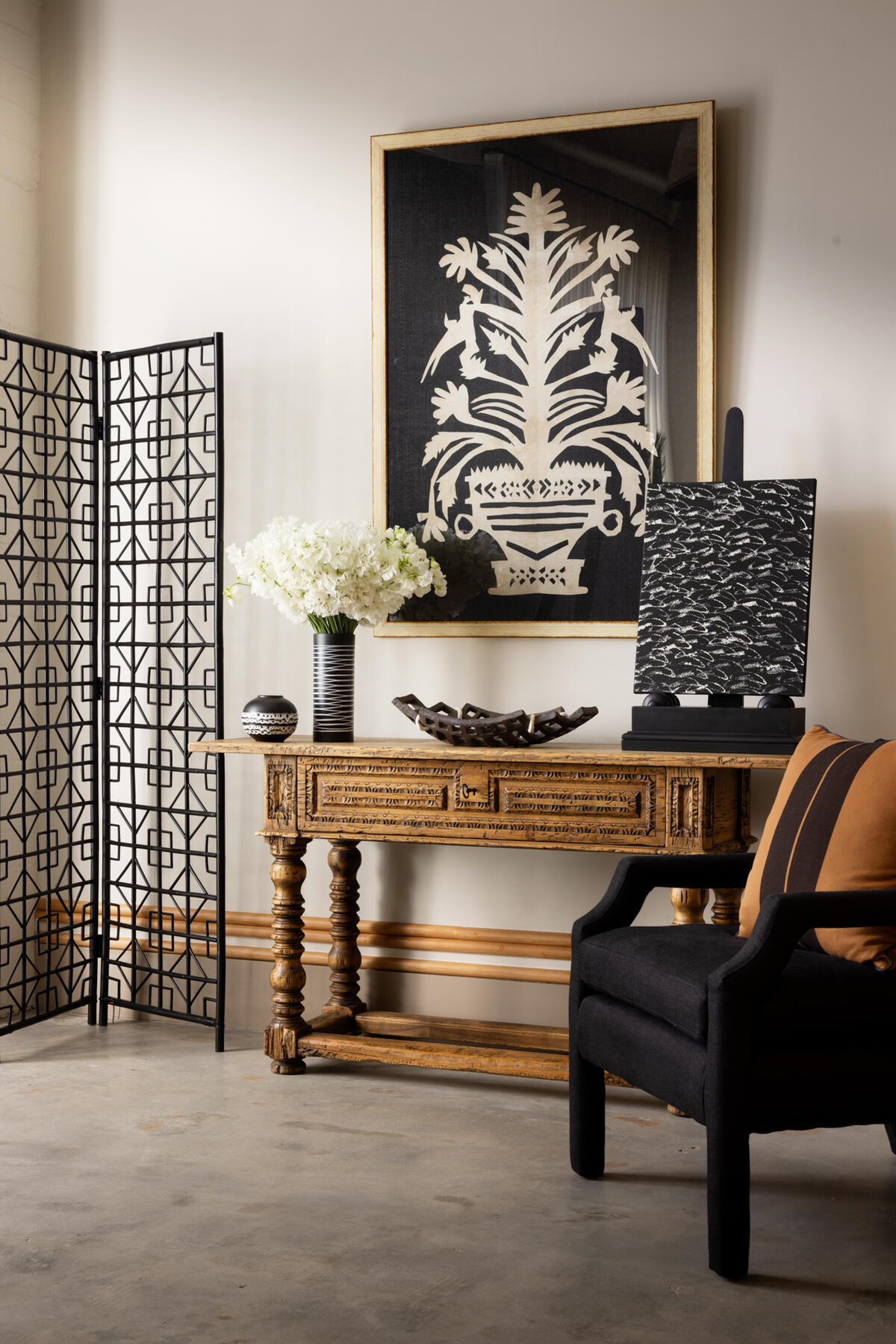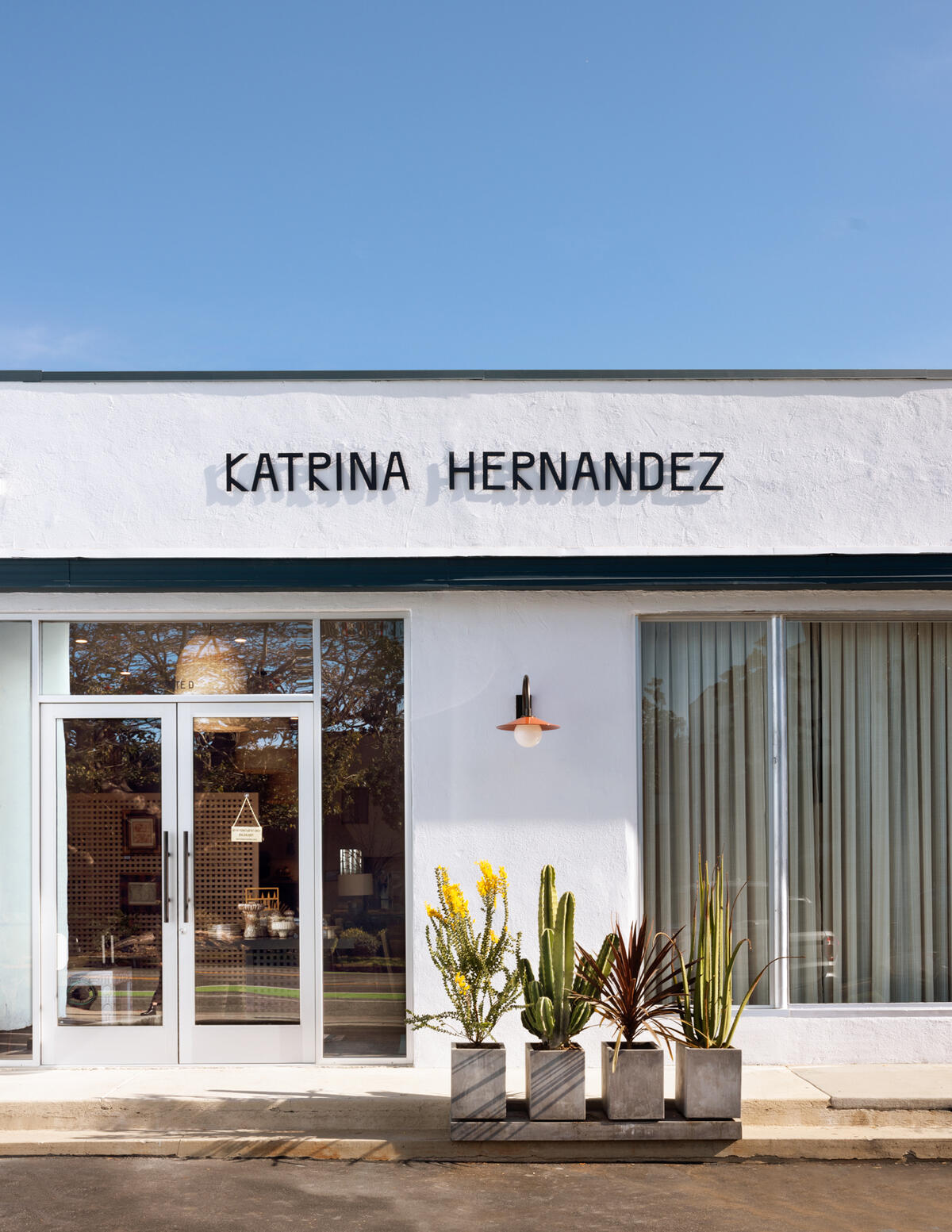In Business of Home’s series Shop Talk, we chat with owners of home furnishings stores across the country to hear about their hard-won lessons and challenges, big and small. This week, we spoke with Katrina Hernandez, who has an eponymous design firm and retail store in Santa Monica, California.
After many years working in fashion and interiors in New York—and taking on residential projects on both coasts—Hernandez made the leap to Los Angeles in 2019. Not long after the move, she began hunting for a retail space on the Westside, where she saw a need for more instantly shoppable furnishings. She landed on a space near the Santa Monica Pier, and a year after the opening, she reflects on her up-and-coming neighborhood, the difficulties of luring L.A. designers into their cars, and the joys of catering (nearly exclusively) to the trade.

What was your career like before the shop?
I started my career in the fashion industry, and that love for textiles continues in my career now. My last [fashion job] was fabric buyer for Ralph Lauren, and then I decided to take a jump with a position at [New York architecture and design firm] Sawyer Berson. I worked my way up on their interiors team and met a partner there, and he and I then went off and started our own firm in New York for about five years. I moved to L.A. and took a minute—because I had another child and it was the pandemic—then restarted my business here, which has been great.
Why did you want to open a store where you did?
When I worked on L.A. projects for many years before living here, I knew my vendors and was used to shopping around, but it was really difficult whenever I had a project on the Westside. It was hard to find places to source from. When we moved here, we moved to Santa Monica, and I thought, ‘What better way to fill this void than to do it myself?’ Because I’m such a curator. I am so particular about things for projects—the quality, the design, everything—that I wanted to be a resource on the Westside.
And it’s close to my home. That was one of the first rules I was told: If you’re living in L.A., you need to work close to your home. Traffic is real. So, I started my business up, and then looked for a space for many years. It’s this perfect location—a beautiful residential neighborhood called North of Montana because it’s really close to a little shopping destination with restaurants called Montana. It’s super close to the Proper [hotel]. I’m close to two other cute stores—Merchant Modern on Lincoln and Stahl + Band, which is on Abbot Kinney in Venice. I think we all [provide] this opportunity to shop in a cooler way, with a stronger point of view.
How would you describe the aesthetic of the store?
Pretty earthy, a little bohemian, very layered. The base of the shop is antiques, warm woods, some newer pieces of furniture in really natural colors. And then it’s layered with textiles, and pillows that I’m making in-house. I just did a collaboration with Schumacher, and we did a pop-up shop, so a lot of their pillows and throws are in [my store] now. I source from about six local ceramicists and six local artists. It feels like a gallery, but it is more accessible—everything is ready to go, off the floor.

How much of your clientele is to-the-trade, and how much is non-trade or foot traffic?
I would say 95 percent is trade and 5 percent is basically friends. I am currently open by appointment only, just until it ramps up further. It enables me to really support the design community; they know that they can come in and have a private appointment, and even bring their clients. I love hosting other designers. They’re clear on what their project needs are, what they’re looking for, what their budgets are. It’s to my advantage to work with the trade.
Can you tell me about a favorite vendor or vendor relationship aside from Schumacher?
Honestly, a lot of the local artists I have connected with have been just wonderful. It’s a very symbiotic relationship. They have understood my aesthetic so well, and I can say, “Hey, this is selling well. Could we get some more of this?” And at the end of the day, they’re artists, but they’re into what I’m creating. They’re making different iterations and exploring what would work with this showroom: They’re putting on their Katrina Hernandez hat. It’s not commissions per se, but this beautiful hybrid of creativity.
A vendor that I absolutely adore is called Miles & Fogg, a plaster artist. … She and I worked together in New York, and she went off to Maine during the pandemic and started this company, and I came across it on Instagram. When she emailed, I was dying when I saw her [full] name. This is kismet! We have a lot of their beautiful plaster mirrors and lamps in the shop, and she’s been a joy to work with again.
What is your merchandising process like?
I would say it’s a little irregular. I feel like this shop has been a long time coming because I’ve had a warehouse for many years [for goods from] wherever I’ve been on my travels. There’s nothing I love more than a good antique market. I love finding local markets to source from, local ceramic studios, meeting new artists. I try to limit my wholesale buying so that I keep this level of authenticity. I think at the end of the day, you always need certain things—candlesticks, baskets, books—that help fill, and which designers are always seeking for the installs. I do buy wholesale that way, but I try to pare it down and make sure the quality is there.
What is the category or item that flies out of the store?
One category is art, which makes me really proud, because like I said, I’m not a gallery. You’re not walking into a Sears Peyton or a Kathryn Markel, but I’ve worked hard to have beautiful pieces at affordable prices that are framed exceptionally so that art is accessible. I think designers have enjoyed that, because when they come in with their clients, they see the art is not breaking the bank. When you have a 5,000-to-10,000-square-foot house, that’s a lot of walls to cover, and not everything can be museumworthy.
And then I’ve been designing these upholstered fabric mirrors in a multitude of shapes and sizes. Currently, we’re offering a rectangle, a circle and a diamond, so we’ll do mini trios of them or a lot of custom for designers—they’ll ask for a floor-length version or an entry mirror. We’ve been having fun with that.

What about your own favorite category?
Because of my textile background, I’ve really been enjoying these mirrors, and making my own pillows for the shop. I will always love working in upholstery, and I want to explore my own textile line at some point.
What is your e-commerce like?
Being a shoestring team, I’m so proud of our e-commerce. I try really hard to make the photography beautiful. The showroom is about 3,000 square feet, and the front half is fully store, and the back half is fully studio-office, and I have a little bit of warehousing back stock. I have a section that’s amazing for shooting. I work hard to make sure everything looks great on the website because at the end of the day—and I can say this as a designer too—we’re all lazy, and we need instant gratification. You’ll go do your due diligence to shop in person, but everything needs to be online [first], with colors, dimensions. And it’s all through Shopify, so it’s a really seamless process to purchase.
It’s incredible that you have that together so soon after opening.
It had to be. I made sure it was done before my opening. I didn’t want to have to worry if a designer needed the tear sheet or more information on a piece. Kerry Joyce was in last week and wanted a bunch of info on a couple pieces he was interested in, and it’s to my benefit to be able to give him those immediately so he doesn’t forget about the pieces. And it’s the way of the future, right?
I don’t currently ship a lot, so I think shipping’s a whole ’nother animal that I haven’t quite mastered. I always tell any of my New York design friends, or any designers who are not nearby: “If there are pieces you’re interested in, I can absolutely figure out how to get them to you. Don’t let that hinder you from purchasing.” But currently it’s local pickup only.
In that vein, how big a role does social media play with the store and your design work?
Social media is great because everyone can always find you. I think no one even uses Google anymore; they’re using Instagram. It’s wild, but it’s true. It’s such a great platform to see a quick snippet of what this creative is about. Any new items I get in, I can put on Instagram. It's a daily reminder for people of what’s in the shop, what’s available. The event that I had with Schumacher last week—“Oh, that’s happening.” It’s a good little news source.
For me personally, I think it’s been great because, unless you’re in a day-to-day relationship with [clients], they may forget about you. I had an old friend/client call me two weeks ago, like “I wanted to reconnect. You could probably do this project in New York for us?” I’m like, “Absolutely, I’d love to work with you guys. Let’s get on a call and discuss it.” It’s just a good reminder for people.

What are some of the challenges you’ve found while operating in L.A., or this neighborhood specifically?
You know what I’m going to say, but traffic is real. Getting the Eastside designers to come over to the Westside is real. I remember when I first opened, I asked Joe Lucas, who owns Harbinger: “How do you get more designers into the shop?” And he was like, “Oh, Katrina, we’re all lazy.”
It’s like your last question—it’s about constant connection and relationship-building with your network to remind them of what you have, what you’re about, and how you can help them.Whatever you can do to make their lives easier. So many designers have said they can come here and get so much. Your clients are tapped out at a certain point; they’ve made so many decisions, and they can’t decide on a single vase or a pair of throw pillows. We allow designers to take pieces on approval, and then a lot of times the clients love them because they see it finally finished. That was the goal: a shoppable showroom for these last-minute pieces, that final layer.
Speaking of getting people into the store, what role do events play in the business?
I just love connection. I love hosting, and the space is so great for that. There’s 14-foot ceilings, so even though it’s 3,000 square feet, it just feels a lot larger. There’s a lot of natural light. It’s really fun to do catering in the evenings; you can mess with the lighting a bit. During the day, it’s beautiful for breakfast. The minute anybody comes, they sit on a piece of furniture and say, “I just want to stay and work here all day.” I’ve heard this comment so often now, and it feels really good.
I’m looking forward to having more events to connect with other creatives, whether it’s a breakfast series with other designers or a “meet the makers” type of event. If there are cool magazines that speak my language and want to host breakfasts here for their teams, I’m open to that as well.
What’s your favorite day as a shop owner?
When designers come in, and they’re pulling for an install or bringing clients to shop. I love helping them find pieces to work into their projects. I love seeing what their style is and what I am able to offer to boost or complement their designs. That’s really fun for me, and it’s just hosting! It fills my bucket. There are some analytics behind it too, which is great—I see what people are liking, what they’re responding to, and make note of that. I always ask designers, “What is hard for you to find in the market?” I can put that answer through my filter and do my version.





























